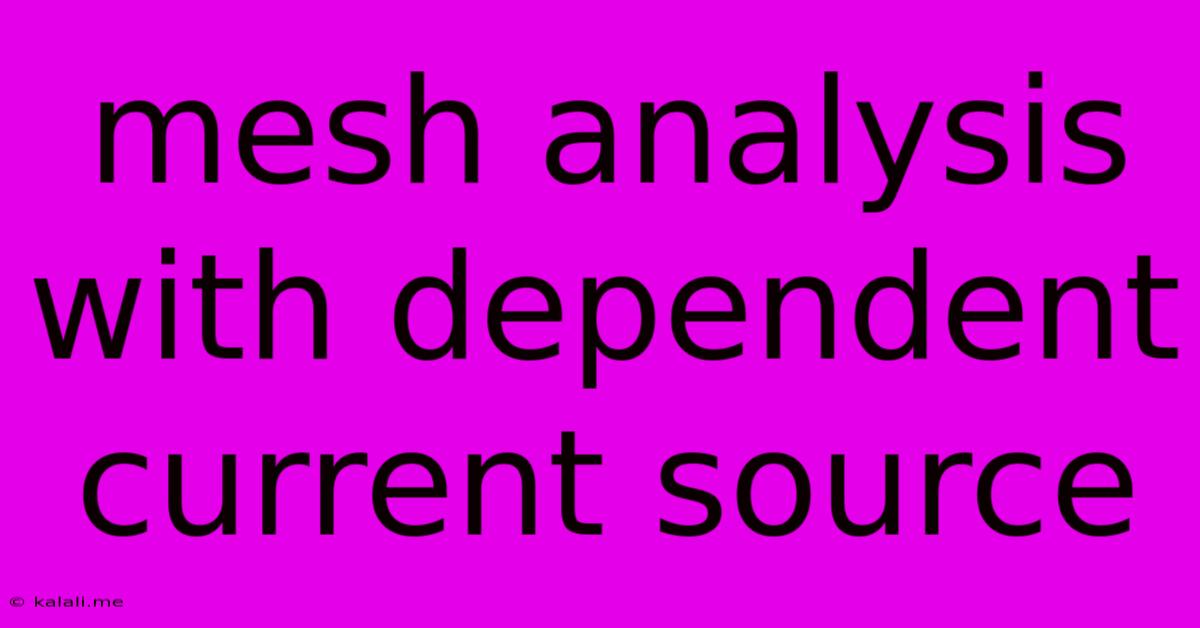Mesh Analysis With Dependent Current Source
Kalali
May 23, 2025 · 3 min read

Table of Contents
Mesh Analysis with Dependent Current Sources: A Comprehensive Guide
Mesh analysis is a powerful circuit analysis technique that simplifies the process of finding currents in planar circuits. While straightforward with independent sources, incorporating dependent current sources adds a layer of complexity. This article provides a comprehensive guide to successfully applying mesh analysis when dealing with circuits containing dependent current sources. Understanding this technique is crucial for anyone tackling advanced circuit analysis problems.
What is Mesh Analysis? Mesh analysis leverages Kirchhoff's voltage law (KVL) to solve for unknown mesh currents. A mesh is a loop in a circuit that doesn't contain any other loops within it. By applying KVL around each mesh, we obtain a system of equations that can be solved simultaneously to determine the mesh currents.
Independent vs. Dependent Sources: Independent sources (voltage and current) have fixed values, unaffected by other circuit elements. Dependent sources, however, have values that depend on another voltage or current within the circuit. This dependence significantly alters the approach to mesh analysis.
Incorporating Dependent Current Sources into Mesh Equations
The key difference lies in how we handle the voltage drop across the dependent current source. Unlike independent sources, we can't simply assign a known voltage. Instead, we must express the voltage in terms of the controlling variable of the dependent source.
Here's a step-by-step process:
-
Identify Meshes and Assign Mesh Currents: Assign clockwise currents (I1, I2, I3, etc.) to each mesh in the circuit. This is a standard practice, but counterclockwise is equally valid. Consistency is key.
-
Write Mesh Equations using KVL: For each mesh, apply KVL, summing the voltage drops around the loop and setting the sum equal to zero. Remember the following voltage-current relationships:
- Resistor: V = IR
- Independent Voltage Source: The voltage is its given value (positive if the current enters the positive terminal).
- Dependent Current Source: The voltage across a dependent current source is not its value multiplied by the resistance. Instead, you need to express this voltage using the other mesh currents or other circuit variables. This often involves applying Ohm's Law to a resistor in series with the dependent current source or using other circuit relationships (like KCL).
-
Express Dependent Source Current in Terms of Mesh Currents: The current of the dependent current source will be expressed as a function of one or more mesh currents. This is determined by the definition of the dependent source.
-
Solve the System of Equations: The resulting system of equations will be simultaneous linear equations. These can be solved using various methods, including matrix methods (e.g., Gaussian elimination, Cramer's rule), substitution, or elimination.
Example:
Let's consider a circuit with a dependent current source controlled by a mesh current. Assume a circuit with two meshes. The equations might look something like this:
- Mesh 1:
R1*I1 + R3*(I1 - I2) + V1 = 0 - Mesh 2:
R2*I2 + R3*(I2 - I1) + k*I1 = 0(where k*I1 represents the dependent current source controlled by I1)
Notice how the voltage across the dependent current source (k*I1) is incorporated into the second mesh equation. Solving these two equations simultaneously will provide the values of I1 and I2.
Tips for Success:
- Careful Sign Conventions: Maintain consistent sign conventions for voltage drops and current directions. Incorrect signs are a common source of error.
- Organized Approach: Use a systematic approach, clearly labeling meshes, currents, and voltage drops.
- Check Your Work: After solving, verify your results by checking if the calculated currents satisfy KVL and KCL.
By mastering these steps, you can confidently tackle circuit analysis problems involving dependent current sources and further enhance your understanding of electrical circuit behavior. Remember that practice is key; work through several examples to solidify your understanding.
Latest Posts
Latest Posts
-
How Many Days Is In 11 Weeks
Jul 14, 2025
-
How Many Grams Are In One Tola Gold
Jul 14, 2025
-
How Many Oz In A Pound Of Freon
Jul 14, 2025
-
How Many Years Are In A Millennia
Jul 14, 2025
-
Words With C As The Second Letter
Jul 14, 2025
Related Post
Thank you for visiting our website which covers about Mesh Analysis With Dependent Current Source . We hope the information provided has been useful to you. Feel free to contact us if you have any questions or need further assistance. See you next time and don't miss to bookmark.